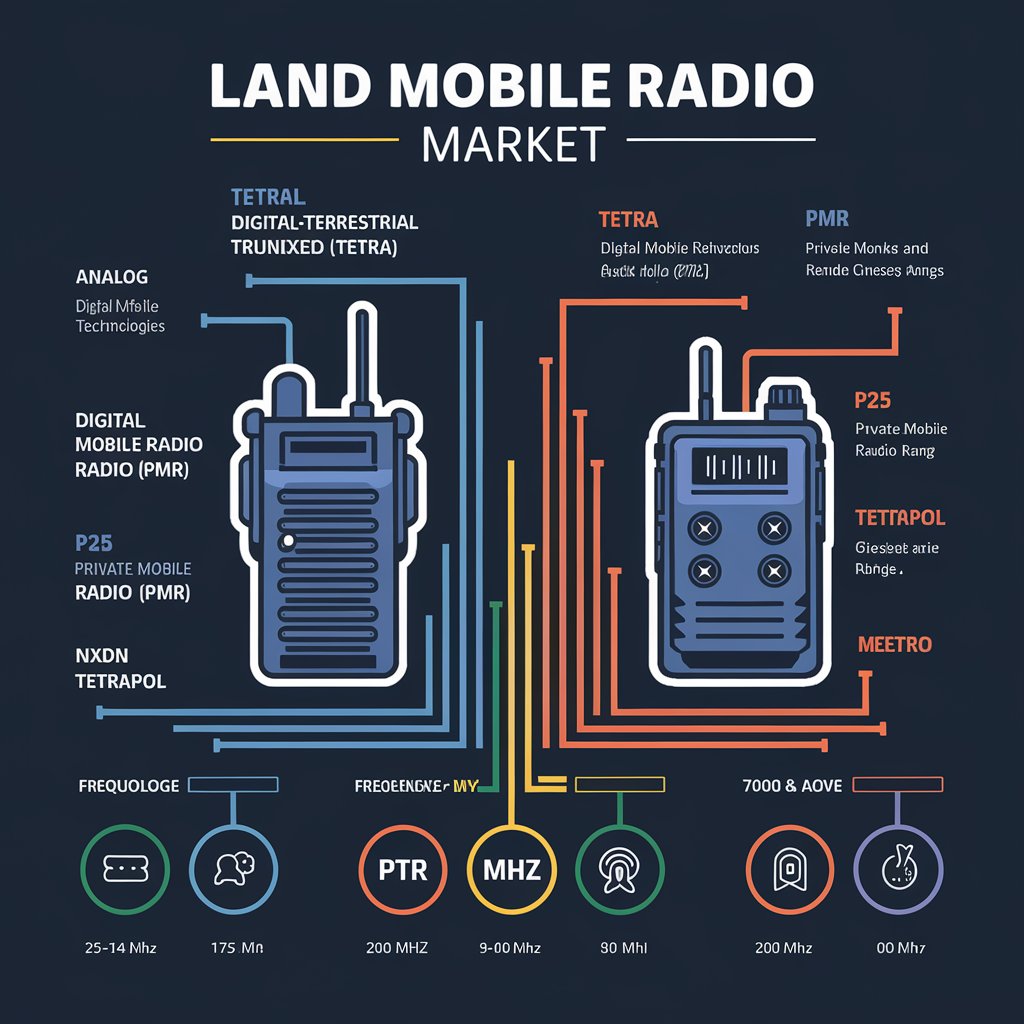Land Mobile Radio (LMR) systems are a vital part of critical communication networks, used across industries such as public safety, defense, transportation, and utilities. As the world continues to advance in digital communication, the future of the LMR industry is being shaped by various technological trends, market demands, and regional factors. In this article, we will explore the trends shaping the future of LMR, market growth projections, leading companies, regional analysis, opportunities, challenges, and industry segmentation.
Trends Shaping the Future of Land Mobile Radio Industry
- Transition to Digital LMR Systems: With the gradual phasing out of analog LMR systems, there is an increasing shift toward digital technology. Digital LMR systems offer enhanced voice clarity, data capabilities, and better encryption for secure communications. Technologies such as Digital Mobile Radio (DMR) and Project 25 (P25) are gaining popularity, enabling better integration with modern networks.
- Integration with LTE and 5G: As LTE and 5G networks expand, there is a growing push to integrate LMR systems with broadband technologies. This hybrid approach allows users to leverage both LMR’s reliability and broadband’s high data speeds for more efficient communication, particularly in mission-critical scenarios.
- Push-to-Talk (PTT) over Cellular (PoC): PoC technology is becoming more prevalent, enabling LMR-like functionality on mobile devices via cellular networks. This trend is reshaping how industries, particularly those in non-mission-critical sectors, adopt communication solutions without investing in traditional LMR infrastructure.
- Increased Focus on Cybersecurity: As LMR systems become more connected to IP networks, they are increasingly vulnerable to cyber threats. This has prompted a surge in cybersecurity measures and solutions to protect communications, ensuring the integrity and confidentiality of mission-critical information.

Land Mobile Radio Market Growth Projection
The global Land Mobile Radio market is expected to witness steady growth, driven by the rising demand for public safety communication systems, modernization of defense infrastructure, and increased adoption in the industrial and commercial sectors. According to industry reports, the land mobile radio market size is projected to grow from USD 17.60 billion in 2024 and is expected to reach USD 28.50 billion by 2029, growing at a CAGR of 10.1% from 2024 to 2029, with strong demand across both developed and developing regions.
Top Companies in the Land Mobile Radio Industry
Several leading companies dominate the Land Mobile Radio industry, continuously innovating and expanding their portfolios to cater to various sectors. Some of the top players include:
- Motorola Solutions: A market leader with a wide range of LMR products, including P25 and DMR systems.
- Harris Corporation (L3Harris Technologies): Known for its advanced public safety and military communication systems.
- Kenwood Corporation (JVCKENWOOD): A key player in providing robust two-way radio solutions.
- Hytera Communications: Offering innovative LMR systems, including digital radios and PoC solutions.
- Tait Communications: Known for delivering LMR solutions tailored to public safety and critical infrastructure.
Regional Analysis
- North America: The largest market for LMR, driven by the extensive adoption of advanced communication technologies in public safety and defense sectors. The U.S. is a key contributor to the region’s dominance, with significant investments in public safety infrastructure.
- Europe: Countries like the UK, Germany, and France are adopting LMR systems for both public safety and commercial applications. Europe is witnessing the integration of LMR with LTE networks to meet the evolving demands of mission-critical communications.
- Asia-Pacific: The region is poised for rapid growth, with increasing investments in LMR systems across public safety, transportation, and utilities sectors. Countries like China and India are key markets, where the focus is on modernizing communication infrastructure.
- Latin America and the Middle East: These regions are experiencing steady growth in LMR adoption, particularly for public safety and defense applications, as governments continue to invest in securing their communication networks.
Opportunities in the Land Mobile Radio Industry
- Modernization of Public Safety Infrastructure: Governments globally are investing in upgrading their public safety communication networks, providing a significant growth opportunity for LMR vendors.
- Expansion of Industrial and Commercial Sectors: Industries such as transportation, utilities, and manufacturing are increasingly adopting LMR systems for improved communication efficiency and worker safety.
- Rising Demand for Push-to-Talk Over Cellular: The growing trend of PoC solutions offers a more flexible and cost-effective communication option, particularly in sectors that do not require traditional LMR systems.
- Cross-Industry Adoption of LMR-LTE Integration: The integration of LMR with LTE networks presents opportunities for enhanced communication solutions across multiple industries, enabling better data transfer and situational awareness.
Challenges Facing the Land Mobile Radio Industry
- Spectrum Scarcity: The growing demand for wireless communication systems is leading to spectrum scarcity, limiting the bandwidth available for LMR operations, particularly in densely populated areas.
- High Initial Costs: Deploying and maintaining LMR systems, especially in mission-critical environments, requires substantial investment, which may deter smaller organizations from adopting LMR solutions.
- Competition from Broadband Solutions: As LTE and 5G networks expand, broadband communication solutions are competing with traditional LMR systems, particularly in non-mission-critical sectors.
- Cybersecurity Concerns: As LMR systems become more interconnected with broadband technologies, they are increasingly exposed to cyber threats, requiring constant upgrades in security measures.
Land Mobile Radio Industry Segmentation
The Land Mobile Radio industry can be segmented based on technology, end-user, application, and geography:
- By Technology: Analog and digital (DMR, P25, TETRA).
- By End-User: Public safety, defense, transportation, utilities, commercial, and industrial sectors.
- By Application: Mission-critical communications, non-mission-critical communications.
- By Geography: North America, Europe, Asia-Pacific, Latin America, and the Middle East & Africa.
The future of the Land Mobile Radio industry looks promising, with advancements in digital LMR systems, increased integration with broadband networks, and the rising demand for mission-critical communication solutions. As the industry evolves, companies will need to focus on innovation, cybersecurity, and integration to stay competitive. With the growing importance of reliable communication networks in various industries, LMR systems are poised to play a vital role in shaping the future of global communication.
